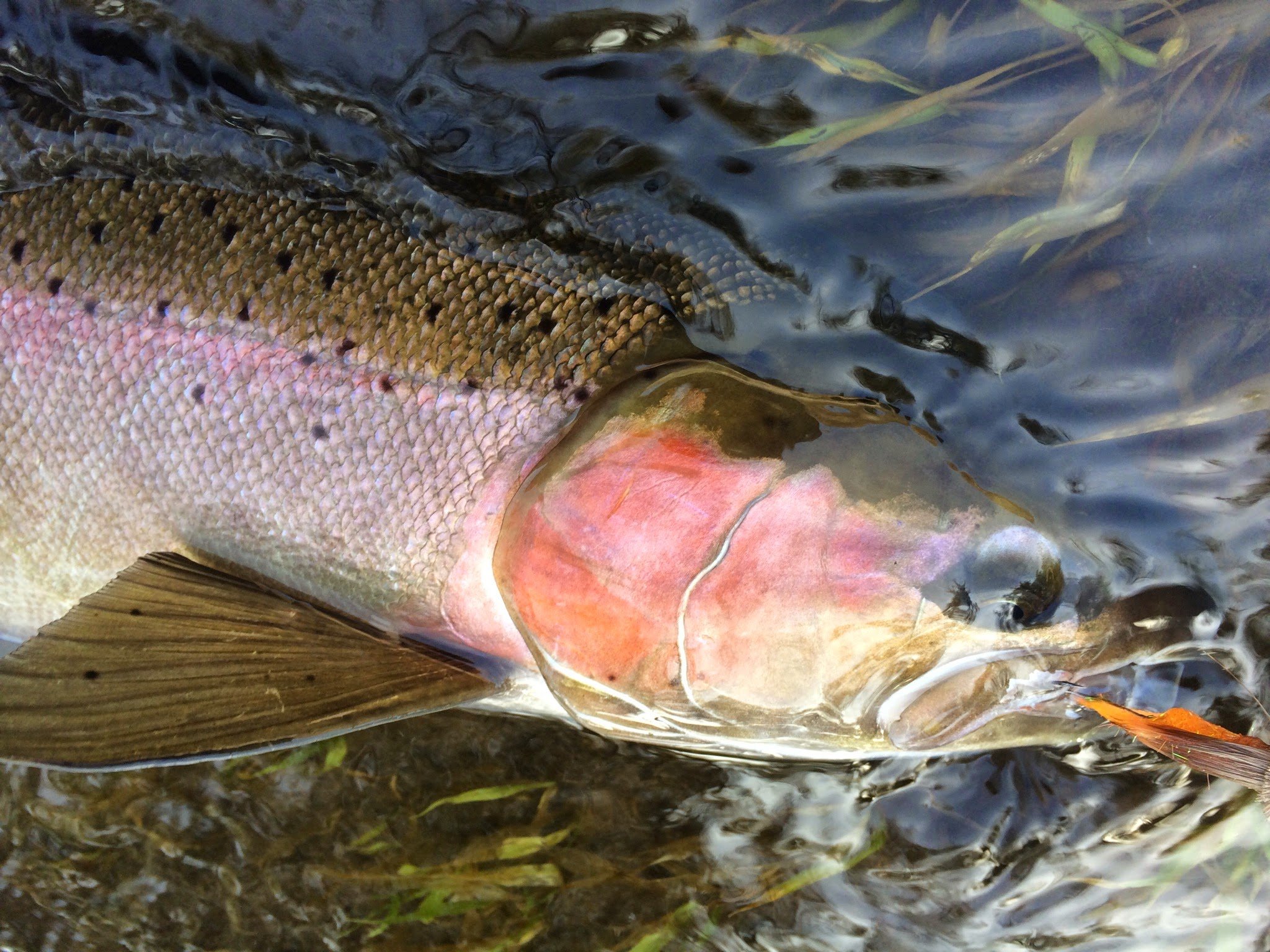Columbia Basin Wild Steelhead -Barely Better & Remain at Risk
Columbia River Summer Steelhead in Fall Color photo by David Moskowitz
by David Moskowitz, Executive Director and John McMillan, Director of Science
Overall, things are looking better than expected for wild summer steelhead in the Columbia River basin.
Of course, we’re now entering the dry, hot slog of August and September. The high streamflows of early summer have dissipated. Fish are now pulling into thermal refuge and the rate of migration will slow.
It’s the Dog Days in baseball terms, figuratively and literally.
Will the surprisingly hot hitter in June and July remain hot for the rest of the season?
Last year was tough on all fronts. It left us all deeply saddened for the wild fish and the loss of opportunity. And while that experience remains fresh and this year’s run isn’t great, we still feel a sense of relief. No one who loves these fish and the rivers they inhabit wants to see a repeat of 2021 - but to just be better than the worst in history is nothing to shout about.
2022 Wild Summer Steelhead Return (as of 8/16) compared to the 2021 wild steelhead return against the most productive ten-year average which occurred from 2001-2010. Source: Col. Riv. Data Access Real Time
Note: the dropping redline indicates the end of the time series, not necessarily a drop in passage numbers.
TCA also understands the challenges of managing wild steelhead fisheries, particularly in a massive river basin where fish are ESA-listed and the fish and their streams are dealing with unprecedented climate effects. To that end, we applaud the early season caution imparted by ODFW’s Deschutes Fisheries Framework - which will benefit wild steelhead in 2022 – but also want to remind anglers that we are still not clearly out of the woods.
In fact, the early-season “strength” in the steelhead return has dropped off sharply. In the first two weeeks of July, the total return was 33% over the current ten-year average . End of July, the total steelhead return was 11% below the ten-year avg. By August 9, the total return was 28% below the ten-year average. By August 15, the total return was 34% below the most recent average.
Wild steelhead were at right at the 10-year on July 15, at only 31% on July 31, increasing to 41% of the ten-year by August 9 and were 45% of the average on August 15.
If things continue at their overall pace, 2022 will be another poor, but possibly manageable, run of wild steelhead into the Columbia and Snake Basins.
And that is the crux of the debate.
How conservative or aggressive do people want to be with an ESA-listed species that is depleted and trying to keep pace with a rapidly changing climate?
We are anglers, each with decades of experience fishing the Deschutes. But we are also conservationists. As such, we try to find a place that best balances current opportunity with the long-term recovery goals and future fishing opportunity for the next generation of anglers.
Even though we practice catch and release, we recognize it comes at a cost: our enjoyment partly depends on us impacting the fish.
Deschutes River Wild Steelhead Photo by Riley Gyerko
We live with that because it is part of who we are as human beings, a cog in an overall larger theatre of nature. But it is also why are so driven to help conserve them. Because we would like to leave the place a little bit better than we found it. Or at least, do our best to keep even.
With climate change that may be unlikely at the broadest scales, but it is doable at smaller scales, like in individual rivers such as the Deschutes.
Accordingly, we also think fisheries, if run smartly and with appropriate caution, can be implemented when run sizes are smaller. However, managing down to lower levels of abundance requires – in our view – a different approach. It requires establishing escapement goals or spawner targets that are sufficient to maintain diversity, spatial structure, productivity, and abundance of wild summer steelhead.
It is possible ODFW’s “minimum abundance threshold” (MAT) would work as a minimum number for that target, but we don’t believe the “critical abundance threshold” (CAT) is a sufficiently conservative target to maintain population resilience through a changing climate. For one or two years, sure. Populations are flexible and can maintain resilience in short bursts of depletion. But relying on such a low goal in a changing climate is too risky for the fish and the fishery.
CATs are thresholds below which the short-term survival of a population is believed to be in considerable doubt.
This is different than an escapement goal or spawner target, which is usually set substantially higher than a CAT and offers a high probability of survival and productivity over a given period, much like the MAT in the Deschutes.
Managing by CAT is like spending down to zero balance and assuming there won’t be an emergency or a mistake. There isn’t any room for error.
More conservative escapement goals ensures there is a buffer for the fish and the fishery.
As part of adapting our fisheries to a changing world, we also think it’s time to revisit the traditional management approach of closure or free-for-all. As agencies have shown in their acumen of managing big game and their deft balance between conservation and opportunity, we can have well-structured fisheries that are based on quality data and helpful models. And frankly, the Deschutes River is often cited as an example of a conservative, but well-managed fishery.
We agree. The Deschutes has a long history of melding science and advocacy.
But their environment is shifting and if predictions are right, run sizes of steelhead and other salmonids will become more variable as a result. Think deeper troughs and lesser peaks.
We will have to adapt if we are serious about the future of the Deschutes. Because the fish are not genetically suited to making such rapid changes.
One way to accomplish this is to establish a sliding scale of impacts, where fishery restrictions become increasingly conservative as forecasted run sizes decline and get closer to the escapement goal.
For example, fisheries could be operated very restrictively when run sizes are expected to be close to or just below the spawner target goal. This would help reduce encounter rates with wild steelhead to ensure that indirect mortality rates don’t lead to the fishery missing its escapement goal. Rule changes that have been implemented for big game and Atlantic salmon offer some suggestions, such as further gear restrictions (e.g., fly fishing only with floating lines and unweighted flies, like on N Umpqua), restricted seasons (e.g., open only 1-2 days/week), limited entry, establishing individual catch and release limits or caps, and caps or reductions on the number of fishing guides. (see additional detail on this subject in the January 2022 Osprey Journal on p. 4)
In that vein, ODFW could use their forecast model based on passage at Bonneville to allow more liberal seasons and gear rules when abundance is forecast to be well above the spawner target, and vice-versa to be conservative when run sizes are forecast to be low.
This wouldn’t avoid closures. Those are part of the new normal moving forward.
Such unpredictability is difficult, we understand. But these are hard times. These are the moments when we need to look in the mirror and ask not what the fish can do for us, but what we can do for the fish.
TCA understands that changing tradition is never easy, but the reality is we are facing a new world. If we want to maintain the wild runs and the fisheries they support, we also have to ensure the populations have sufficient diversity and resilience to persist through climate change.
We All Want to Be Here.
We can do our part, individually and collectively, by supporting measures that put the health of wild summer steelhead first in the Deschutes and other rivers supporting wild summer steelhead.
For a detailed assessment of the health of Columbia River Steelhead, please check out the link below.
The Conservation Angler Remarks on 2022 Columbia River Wild Summer Steelhead







